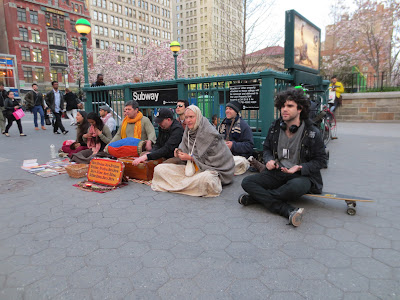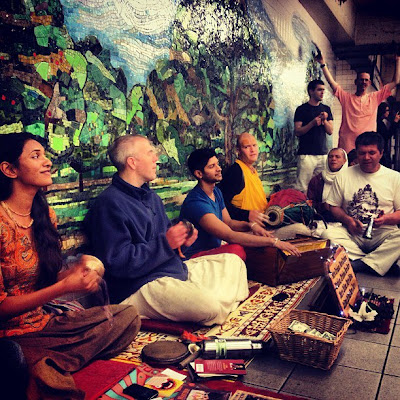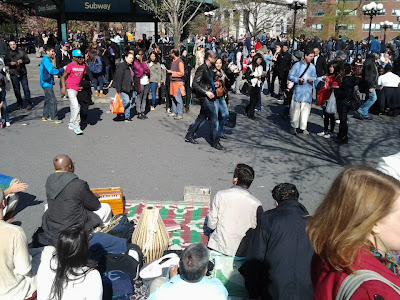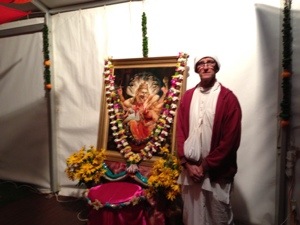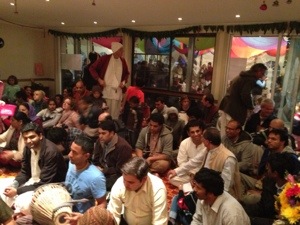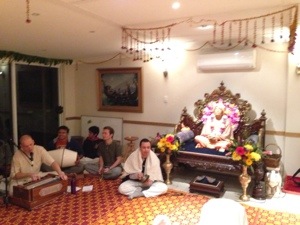Uddhava-gītā US Retreat – Day 1 – Evening Lecture
Nrisimhadeva, Every Day, Everywhere
→ Karnamrita.das's blog
(this blog is recorded on the full page: quick time player needed; works best with Firefox or Explorer)
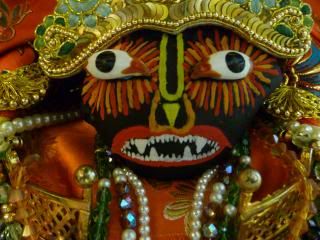
Shri Nrisimhadeva's appearance is one of my favorite holy days. His lila is so illuminating and important. Though I wanted to prepare this offering by the actual day, it wasn't meant to be--occurrences and other duties diverted me--and yet, that is also part of the teaching: to see everything in relationship to God and to keep a humble service mood throughout. Whether pulling weeds and planting, or having one's car battery die--everything is instructive. In this case, reminding me to keep my devotional creeper free of "weeds", and that I must recharge my batteries with spiritual practice. May the fire of spiritual life burn brightly in our hearts and souls!
Unusual life events
intersect with special days
strange creatures prepare us
emerging from the ground
shedding their skins to fly
teaching us to transform
if we want to dwell in the sky
realizing our true self
keeping our purpose in mind
always vibrating the primal sound
the great chant for deliverance
17 year cicada’s ballad serenades
Lord Nrisimhadeva’s appearance.

Eerie sounds like alien starships
reminding us of the extraordinary
half man, half lion incarnation
Nrisimhadeva, Every Day, Everywhere
→ Karnamrita.das's blog
(this blog is recorded on the full page: quick time player needed; works best with Firefox or Explorer)

Shri Nrisimhadeva's appearance is one of my favorite holy days. His lila is so illuminating and important. Though I wanted to prepare this offering by the actual day, it wasn't meant to be--occurrences and other duties diverted me--and yet, that is also part of the teaching: to see everything in relationship to God and to keep a humble service mood throughout. Whether pulling weeds and planting, or having one's car battery die--everything is instructive. In this case, reminding me to keep my devotional creeper free of "weeds", and that I must recharge my batteries with spiritual practice. May the fire of spiritual life burn brightly in our hearts and souls!
Unusual life events
intersect with special days
strange creatures prepare us
emerging from the ground
shedding their skins to fly
teaching us to transform
if we want to dwell in the sky
realizing our true self
keeping our purpose in mind
always vibrating the primal sound
the great chant for deliverance
17 year cicada’s ballad serenades
Lord Nrisimhadeva’s appearance.

Eerie sounds like alien starships
reminding us of the extraordinary
half man, half lion incarnation
Radhanath Swami – Stories of Inspiration & Hope for Women and the World
→ Gouranga TV - The Hare Krishna video collection
Radhanath Swami – Stories of Inspiration & Hope for Women and the World
Uddhava-gītā US Retreat – Day 1 Mid-Morning Session
Bhakti Charu Swami
Educational Week Ahead!
→ The Toronto Hare Krishna Blog!
 Our summer continues to get busier as we welcome Uttama and Partha prabhus to Toronto this week!
Our summer continues to get busier as we welcome Uttama and Partha prabhus to Toronto this week!Their visit is in a series from the Grihastha Vision Team (GVT) that is focused on educating and preparing members of the community towards spiritually married life as well as supporting strong family connections.
They will be facilitating seminars and events throughout the next week geared towards those entering married life as well as be available for private consultation.
Schedule (subject to change):
Saturday, June 1st:
1:00pm - 4:30pm: "How not to Marry a Jerk" Seminar
***Attendees: please bring your own notebook as you will need it for exercises!***
6:30pm - 8:30pm: Evening Event for Singles
Sunday, June 2nd:
6:30pm - 7:15pm: Sunday Feast Class
Monday, June 3rd:
6:30pm - 8:30pm: Man to Man/ Woman to Woman Sessions for Single Devotees
Wednesday, June 5th:
6:30pm - 8:30pm: Couples Evening - "The Five Love Languages"
Thursday, June 6th:
6:30pm - 8:30pm: Man to Man/ Woman to Woman Sessions for Everyone
For more information, please contact Yogendra das. We hope you can join us for what will be an informative week!
Educational Week Ahead!
→ The Toronto Hare Krishna Blog!
 Our summer continues to get busier as we welcome Uttama and Partha prabhus to Toronto this week!
Our summer continues to get busier as we welcome Uttama and Partha prabhus to Toronto this week!Their visit is in a series from the Grihastha Vision Team (GVT) that is focused on educating and preparing members of the community towards spiritually married life as well as supporting strong family connections.
They will be facilitating seminars and events throughout the next week geared towards those entering married life as well as be available for private consultation.
Schedule (subject to change):
Saturday, June 1st:
1:00pm - 4:30pm: "How not to Marry a Jerk" Seminar
***Attendees: please bring your own notebook as you will need it for exercises!***
6:30pm - 8:30pm: Evening Event for Singles
Sunday, June 2nd:
6:30pm - 7:15pm: Sunday Feast Class
Monday, June 3rd:
6:30pm - 8:30pm: Man to Man/ Woman to Woman Sessions for Single Devotees
Wednesday, June 5th:
6:30pm - 8:30pm: Couples Evening - "The Five Love Languages"
Thursday, June 6th:
6:30pm - 8:30pm: Man to Man/ Woman to Woman Sessions for Everyone
For more information, please contact Yogendra das. We hope you can join us for what will be an informative week!
Uddhava-gītā US Retreat – Day 1 – Introduction
Bhakti Charu Swami
No more death!
→ Servant of the Servant
I was listening to Prabhupada lecture and found the below narration highly inspirational hence sharing here.
So mrtyu, death, is stopped as soon as you take Krsna consciousness very seriously, immediately, from that moment, as soon as you are initiated. You promise before the spiritual master, "Yes, I am initiated, I shall act like this," and if you follow, then your death is stopped from that point. No more death. No more death. Simply an official business, just like you sleep and again you awake, similarly, a devotee's death is like that. It is like sleeping, and next moment in the spiritual kingdom, immediately. Immediately. When he will rise, he will see that "I am with Krsna." This is the fact!
No more death!
→ Servant of the Servant
I was listening to Prabhupada lecture and found the below narration highly inspirational hence sharing here.
So mrtyu, death, is stopped as soon as you take Krsna consciousness very seriously, immediately, from that moment, as soon as you are initiated. You promise before the spiritual master, "Yes, I am initiated, I shall act like this," and if you follow, then your death is stopped from that point. No more death. No more death. Simply an official business, just like you sleep and again you awake, similarly, a devotee's death is like that. It is like sleeping, and next moment in the spiritual kingdom, immediately. Immediately. When he will rise, he will see that "I am with Krsna." This is the fact!
IF YOU ARE LOOKING FOR A NEW …
→ GITA COACHING
IF YOU ARE LOOKING FOR A NEW …
→ GITA COACHING
Vyasa Puja Address Lecture by Radhanath Swami
→ Gouranga TV - The Hare Krishna video collection
Vyasa Puja Address Lecture by Radhanath Swami
10-Giriraja Swami – The Importance of Self Care
→ Successful Vaisnavas – Personal Development for Hare Krishnas
In this episode H.H. Giriraj Swami talks about Stephen Covey‘s concept of maturity as the “balance between courage and consideration” (win-win). He shows how we need to look after ourselves if we want to keep helping others. To learn more about His Holiness Giriraja Swami visit: http://www.girirajswami.com/ Other topics in this episode: Hear more about […]
The post 10-Giriraja Swami – The Importance of Self Care appeared first on Successful Vaisnavas - Personal Development for Hare Krishnas.
10-Giriraja Swami – The Importance of Self Care
→ Successful Vaisnavas
 In this episode H.H. Giriraj Swami talks about Stephen Covey‘s concept of maturity as the “balance between courage and consideration” (win-win). He shows how we need to look after ourselves if we want to keep helping others.
In this episode H.H. Giriraj Swami talks about Stephen Covey‘s concept of maturity as the “balance between courage and consideration” (win-win). He shows how we need to look after ourselves if we want to keep helping others.
To learn more about His Holiness Giriraja Swami visit:
Other topics in this episode:
Hear more about the “clean up the house” project.
To learn about the Successful Vaisnavas Online Course and to watch the latest hangout go to http://successfulvaisnavas.com/hangout
Leave a comment below or to leave a voice message using the popup box on the right.
Make your life successful.
Your servant,
Krsnendu dasa
A River of Nectar
→ travelingmonk.com
Travel Journal#9.8: New York, London, Amsterdam, and More
→ Travel Adventures of a Krishna Monk
By Krishna-kripa das
(April 2013, part two)
(Sent from Newcastle upon Tyne, England, on May 28, 2013)
to chant sixteen rounds is the most essential,’ wrote
Prabhupada. We have taken a solemn
vow at the time of our initiation. We
learn to chant avoiding the ten offenses
and then the whole panorama of Krishna’s fame,
qualities, pastimes and Krishna Himself
is revealed to us. Who is such a fool
that he will not take to the chanting
and hearing of the holy names?”
the others for lunch today.
Eating alone is good as
occasional relief. I like
to be with the devotees
even if it causes a
certain strain because
it’s my duty to sit with
them and hear the Bhagavatam
and then personal
conversations. I want
to please and serve
them by my presence.”
I discovered
that Srila Prabhupada was a perfect psychologist.
He assured us that we were fortunate and happy.
We have given up sinful life and
attained Krishna consciousness
so no one should be despondent.
But Prabhupada also made it clear
we are not Vaisnavas
but servants of the Vaisnavas.
A pure devotee is very rare.
He was expert and did it subtly
so no one noticed how—
giving us confidence and humility at the same time.
And what he gave we accepted.”
Travel Journal#9.8: New York, London, Amsterdam, and More
→ Travel Adventures of a Krishna Monk
By Krishna-kripa das
(April 2013, part two)
(Sent from Newcastle upon Tyne, England, on May 28, 2013)
to chant sixteen rounds is the most essential,’ wrote
Prabhupada. We have taken a solemn
vow at the time of our initiation. We
learn to chant avoiding the ten offenses
and then the whole panorama of Krishna’s fame,
qualities, pastimes and Krishna Himself
is revealed to us. Who is such a fool
that he will not take to the chanting
and hearing of the holy names?”
the others for lunch today.
Eating alone is good as
occasional relief. I like
to be with the devotees
even if it causes a
certain strain because
it’s my duty to sit with
them and hear the Bhagavatam
and then personal
conversations. I want
to please and serve
them by my presence.”
I discovered
that Srila Prabhupada was a perfect psychologist.
He assured us that we were fortunate and happy.
We have given up sinful life and
attained Krishna consciousness
so no one should be despondent.
But Prabhupada also made it clear
we are not Vaisnavas
but servants of the Vaisnavas.
A pure devotee is very rare.
He was expert and did it subtly
so no one noticed how—
giving us confidence and humility at the same time.
And what he gave we accepted.”
Devotee Association – Most Essential Element in Krishna Consciousness
→ Servant of the Servant
- Srila Bhaktisiddhanta Sarasvati Thakur (Page No.17 and 18 of the book ‘Amrta Vani’)
Devotee Association – Most Essential Element in Krishna Consciousness
→ Servant of the Servant
- Srila Bhaktisiddhanta Sarasvati Thakur (Page No.17 and 18 of the book ‘Amrta Vani’)
Sadhu Sanga Notes – HH Sacinandana Swami’s class "Faith III – Prajña Nuggets Prospector"
→ Nityananda Chandra Das' Blog, ISKCON Dallas
SB 07.09.18 Sacinandana Swami
Sum: Prahlada expresses his deep faith in the chanting the holy names of the Lord.
Two minds sets for the this festival.
1. Let me see what is happening.
2. Or How can use the days to the best of my abilities how can I go deeper.
As a neutral observer or an active participant.
Faith III
Faith is the ground on which we walk.
No faith no results.
Two things in the beginning. Place. A resting place
Viśvanātha Cakravartī Thakura says it is sastra & process
Śaraṇām gacah
Faith and surrender
Faith in the upaya, the sadhana, by which you reach your upeya, the goal.
Gold nuggets in Alaska. Journey made on faith, so much austerities.
As one attempts to find gold whether he is successful or not.
Jīva Goswami
Virya strength comes from faith, no wobbly knees
smriti remembrance, clarity
Prajña realization of Krishna.
Samadhi Nama samadhi
"Sanga is the birth place of faith"
Therapeutic efforts.
Prajña nuggets prospector
Story of Sumanasena Maharaja.
Nārada Muni came, why depressed?
Yes help me. Are youu Bahir Mukha or Antar Mukha.
You body will have you smelly body go quickly down a river.
Only thing permanent, Bhakti. When Kali Yuga come, Gauranga.
Chanting Pancha Tattva
But he wanted to see Lord Caitanya
Then one night a dream
A golden flash in a dark night.
QUESTIONS
Question 1: the king he had no faith. He got he highest associating. Faith vs association.
Answer: One make offenses & seal heart off
Or
Left me follow. - Viśvanātha Cakravartī Thakura
Did not seal off. Open his heart.
Question 2: difference between intellectually understand. In the mind Vs movement of heart.
Answer: How do we know the difference.
When we get the fruit.
A matti? Will arise. Leaning towards goal. Encouraged good, discouraged then did not work. Not to validated in our maya. No prajalpa
Sadhu Sanga Notes – HH Sacinandana Swami’s class "Faith III – Prajña Nuggets Prospector"
→ Nityananda Chandra Das' Blog, ISKCON Dallas
SB 07.09.18 Sacinandana Swami
Sum: Prahlada expresses his deep faith in the chanting the holy names of the Lord.
Two minds sets for the this festival.
1. Let me see what is happening.
2. Or How can use the days to the best of my abilities how can I go deeper.
As a neutral observer or an active participant.
Faith III
Faith is the ground on which we walk.
No faith no results.
Two things in the beginning. Place. A resting place
Viśvanātha Cakravartī Thakura says it is sastra & process
Śaraṇām gacah
Faith and surrender
Faith in the upaya, the sadhana, by which you reach your upeya, the goal.
Gold nuggets in Alaska. Journey made on faith, so much austerities.
As one attempts to find gold whether he is successful or not.
Jīva Goswami
Virya strength comes from faith, no wobbly knees
smriti remembrance, clarity
Prajña realization of Krishna.
Samadhi Nama samadhi
"Sanga is the birth place of faith"
Therapeutic efforts.
Prajña nuggets prospector
Story of Sumanasena Maharaja.
Nārada Muni came, why depressed?
Yes help me. Are youu Bahir Mukha or Antar Mukha.
You body will have you smelly body go quickly down a river.
Only thing permanent, Bhakti. When Kali Yuga come, Gauranga.
Chanting Pancha Tattva
But he wanted to see Lord Caitanya
Then one night a dream
A golden flash in a dark night.
QUESTIONS
Question 1: the king he had no faith. He got he highest associating. Faith vs association.
Answer: One make offenses & seal heart off
Or
Left me follow. - Viśvanātha Cakravartī Thakura
Did not seal off. Open his heart.
Question 2: difference between intellectually understand. In the mind Vs movement of heart.
Answer: How do we know the difference.
When we get the fruit.
A matti? Will arise. Leaning towards goal. Encouraged good, discouraged then did not work. Not to validated in our maya. No prajalpa
Sadhu Sanga Notes–Realizations of Senior Vaisnavas
→ Nityananda Chandra Das' Blog, ISKCON Dallas
Dhanudhara Swami - 10 sentences about Sadhu Sanga
Nityananda Prabhu - liberate the 3 worlds, ABCDE,
Gaura Sakti - anarthas dissolving,
Mother Chandravali - amazing, I thought I had to go to India.
Braja Mandala Priya - only shelter, holy name,
Purushartha Prabhu - the bass player - saintly persons all leading kirtan, book distribution. Now a new wave, hours and hours of kirtan festivals.
Sudevi Sundari - my husbands name sake. Thanking all the helpers. Thanking Indradyumna Swami.
Mother Kosa Rupa - last year I thought that this was the best festival. This weekend was especially wonderful, I got to meet so many wonderful devotees, new devotees will chant all the way Back to Godhead.
Edhaniaswabhava - giving thanks
Devarsi - no anxiety, just come and chant.
Syamala Kisori - so many great devotees helped us to focus on the only name.
Lila suka - top most favorite gathering, even though I am from Alachua
Nityānanda Chandra Dās - dreams of Krishna
Kapil Patel - reflecting on Kirtans, this helped me chant deeper.
Lalita Madhavi - thank Maharaja and others
Sundara - cry out to the Holy Name,
Mother Guru Bhakti - so much better than last year. New people were blown away. What people are looking for.
List of thanks.
Kirtaniyas
cooks
Transportation
VIS Very Important Sadhus hospitality
Child care
Registration
Deity Sevaka
Clean up crew
Flight arrangement
CYJ Helpers
Organizers
Indradyumna Swami - thanks Caturatma.
My heart of hearts is bringing Krishna to the public. I haven't been to a temple in months due travel festivals. But I feel that this festival is like a reward.
Sadhu Sanga Notes–HH Giriraj Swami’s Class “Śrīla Prabhupāda’s Kirtan World Revolution”
→ Nityananda Chandra Das' Blog, ISKCON Dallas
Giriraj Swami
Memorial Day weekend there is a Prabhupada Festival in Los Angeles.
“I hope you can change your plans.” – Indradyumna Swami
Prabhupada's Sanskrit editor, Pradyumna Prabhu said a Striking statement.
Śrīla Prabhupāda took the same principles. That most acharyas take it for personal advancement to the advancement of the world.
Purport of this verse refers to Cetah Darpana marjanam.
It shows his inner mood. Śrīla Prabhupāda is telling us what is going on inside him. He wants the leaders of the world to take it. So Revolutionary
Reforming the world.
Tamal Krishna Goswami had a hernia operation. There was no phone.
America phone story with Śrīla Prabhupāda “Is this the time to inquire”
They decided to the hospital. Śrīla Prabhupāda was so concerned about Tamal Krishna Goswami.
When he was wheeled out, he said. “I just I had a dream. You were reporting to previous acharyas on your preaching mission, you said on Earth they have:
No good qualities.
No knowledge
No background
But one good quality
What ever I tell them they do.”
That is the what Śrīla Prabhupāda is saying in this purport.
Did not care even if they were not Indian.
Smartas say. Greatest disservice by giving sacred thread.
What is more powerful Paapa or Naaama. .?
Tree of Lord Caitanya
Rupa and Sanantan, the best of all.
They spread Krishna Consciousness in pascyamdesha.
How does Kaviraja Goswami describe such residents,no good behavior or well educated and etc
And trained them
When Śrīla Prabhupāda returned to India he went to a Sadhu Mela on the sands of Chowpatty
Long winded dry talks by impersonalist.
Śrīla Prabhupāda instead did kirtan
Malati then got everyone dancing.
"I don't wish to speak much" He said.
But these Americans. Sad achar
They had never seen white sadhus. Nor such enthusiasm.
One man said, "”I get people to chant Hare Krishna for health, can we join forces?”
“No! We serve Naama”
Our own worse enemy like the panic of a drowning man is his worse enemy
Reflections from the 2013 Sadhu Sanga Retreat
→ Trying to reach a state of equilibrium....
HG Sridama dasa – Advent of Sita – consort of Lord Ram
→ Gouranga TV - The Hare Krishna video collection
HG Sridama dasa – Advent of Sita – consort of Lord Ram
Deity Darshan: 5/26/2013
→ The Toronto Hare Krishna Blog!
Deity Darshan: 5/26/2013
→ The Toronto Hare Krishna Blog!
ISKCON Scarborough- Grand Narasimhadev caturdasi celebrations
→ ISKCON Scarborough
ISKCON Scarborough- Grand Narasimhadev caturdasi celebrations
→ ISKCON Scarborough
The Way to Prosperity
→ travelingmonk.com
YOU NEED TO PAY – EVERY SINGLE DAY
→ GITA COACHING
HG Bhuta Bhavana dasa – 5th may
→ Gouranga TV - The Hare Krishna video collection
HG Bhuta Bhavana dasa – 5th may
29 May 2013 – Disappearance Day of Sri Ramananda Raya
→ ISKCON Desire Tree
Nrsimha Caturdasi
→ Ramai Swami
Sri-nrsimha, jaya nrsimha, jaya jaya nrsimha
prahladesa jaya padma-mukha-padma-bhrnga
All glories to Nrsimha-deva! All glories to Nrsimha-deva, who is the Lord of Prahlada Maharaja and, like a honeybee, is always engaged in beholding the lotus like face of the goddess of fortune.
Ugro ‘py anugra evayam sva-bhaktanam nr-kesari
kesariva sva-potanam anyesam ugra-vikramah
Although very ferocious, the lioness is very kind to her cubs. Similarly,
although very ferocious to non-devotees like Hiranyakasipu, Lord
Nrsimha-deva is very, very soft and kind to devotees like Prahlada Maharaja.
The devotees gathered at the Brisbane temple in Jennifer Street to celebrate the auspicious appearance of Lord Nrsimhadeva. It is said that anyone who hears the story of The Lord and His devotee Prahlada Maharaja, will be liberated from this material world and transferred to the spiritual abode very soon.
GITA AND COACHING
→ GITA COACHING
HOLY STRONGER SONG BY ANAMARIJA
→ GITA COACHING
HOLA
Holy Stronger is a song by our Gita Band.
HH Kesava Bharati Swami – Guru Puja 20130521
→ Gouranga TV - The Hare Krishna video collection
HH Kesava Bharati Swami – Guru Puja 20130521

